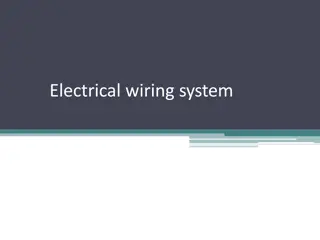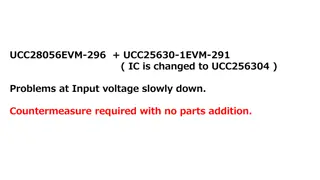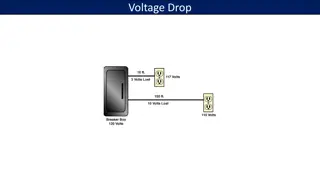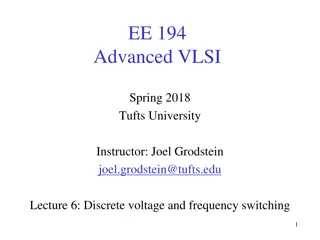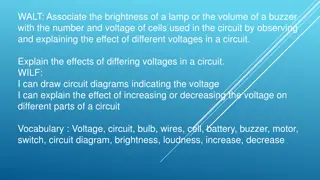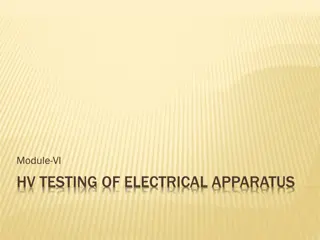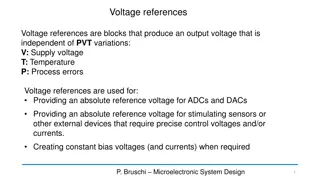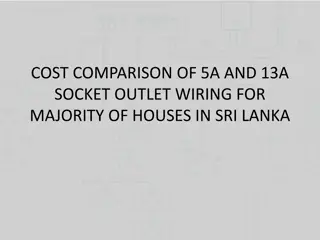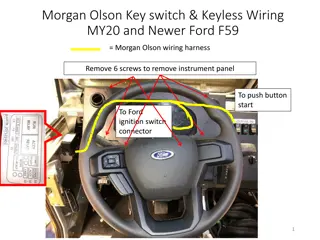Voltage Readings and Rules for Troubleshooting Wiring and System Issues
Data on voltage readings derived from bench testing in a controlled environment are provided as a reference for troubleshooting wiring and unit issues. General rules and guidelines for voltage measurements at various locations within the system are outlined, along with specific instructions for continuity checks in entrance stations with different configurations. The document emphasizes the importance of using voltage readings in conjunction with other methods to identify and resolve issues effectively.
Download Presentation

Please find below an Image/Link to download the presentation.
The content on the website is provided AS IS for your information and personal use only. It may not be sold, licensed, or shared on other websites without obtaining consent from the author. Download presentation by click this link. If you encounter any issues during the download, it is possible that the publisher has removed the file from their server.
E N D
Presentation Transcript
Caution Voltage readings in this document are data that was taken based on bench testing in a controlled environment with a small system and short wiring distances. The data is not in any way the specifications for the products and onsite voltage readings may differ slightly so it should only be used as a reference for troubleshooting wiring issues and unit issues. Like all testing methods, voltage readings will not be able to evaluate every issue and should be used in conjunction with other methods in order to clearly define the issue
General rules At every location, R1 and R2 audio lines should measure 24V if the system is powered In a standard system without any additional GT-VBC, B1,B2 tenant station side video lines only show 24V if the video is active on the system (in programming mode or calling/communication state) Voltage at GT-VBC differs depending on if it is in a standard or expanded system and also if it is used as an extended unit from another GT-VBC.
Entrance Stations Audio Only Modular Entrance Continuity check when releasing door. ELB,ELC is NC and ELM,ELC is NO. No change in continuity indicates fault with unit. Note that if door strike/gate is powered, the voltage of the power supply will be seen depending on the relay state. Approx +24V when system is powered up. If 0V or significantly lower voltage, check GT- BC or wiring of distribution point. -24V will indicate incorrect polarity of R1 and R2 but it should still function.
Entrance Stations Audio Only Modular Entrance w/ keypad Continuity check when releasing door. ELB,ELC is NC and ELM,ELC is NO. No change in continuity indicates fault with unit. Note that if door strike/gate is powered, the voltage of the power supply will be seen depending on the relay state. Approx +24V when system is powered up. If 0V or significantly lower voltage, check GT- BC or wiring of distribution point. -24V will indicate incorrect polarity of R1 and R2 but it should still function. Approx +24V when powered up. If 0V or significantly lower voltage, check power supply or wiring between.
Entrance Stations Audio+Video Modular Entrance Approx +24V when system is powered up. If 0V or significantly lower voltage, check GT- VBC for standard/GT-VBX for expanded or wiring between. -24V will indicate incorrect polarity of A1 and A2 but it should still function. There will be voltage drop from 24V when calling or in communication Continuity check when releasing door. ELB,ELC is NC and ELM,ELC is NO. No change in continuity indicates fault with unit. Note that if door strike/gate is powered, the voltage of the power supply will be seen depending on the relay state. Approx +24V when system is powered up. If 0V or significantly lower voltage, check GT-BC or wiring of distribution point. -24V will indicate incorrect polarity of R1 and R2 but it should still function. Approx +24V when powered up. If 0V or significantly lower voltage, check power supply or wiring between.
Entrance Stations Approx +24V when system is powered up. If 0V or significantly lower voltage, check GT- VBC for standard/GT-VBX for expanded or wiring between. -24V will indicate incorrect polarity of A1 and A2. GT-DM There will be voltage drop from 24V when calling or in communication Continuity check when releasing door. ELB,ELC is NC and ELM,ELC is NO. No change in continuity indicates fault with unit. Note that if door strike/gate is powered, the voltage of the power supply will be seen depending on the relay state. Approx +24V when system is powered up. If 0V or significantly lower voltage, check GT-BC or wiring of distribution point. -24V will indicate incorrect polarity of R1 and R2 Approx +24V when powered up. If 0V or significantly lower voltage, check power supply or wiring between.
Bus Controllers GT-BC The GT-BC powers R1,R2 to tenant stations, entrance stations and expanded bus controllers Approx +24V when powered up. If 0V or significantly lower voltage, check if the GT-BC is switched on and check power supply voltage. -24V will indicate incorrect polarity of R1 and R2 but it should still function. to distribution point Approx +24V when powered up. If 0V or significantly lower voltage, check power supply or wiring between.
Bus Controllers GT-VBC Standard Mode GT-VBC in a standard system in standard mode The GT-VBC powers A1,A2 to entrance stations, powers B1,B2 to tenant stations when active* Approx +24V when powered up. If 0V or significantly lower voltage, check if the GT-BC is switched on and check power supply voltage. -24V will indicate incorrect polarity of R1 and R2 but it should still function. Approx +24V when powered up. If 0V or significantly lower voltage, check power supply or wiring between.
Bus Controllers GT-VBC Expanded Mode GT-VBC extended from another GT-VBC in a standard system Approx +24V when powered up. If 0V or significantly lower voltage, check power supply or wiring between.
Bus Controllers In an expanded system, the GT-VBC output is controlled by the GT-VBX which is powered by the GT-BCX. GT-VBC Expanded Mode GT-VBC in an expanded system (adjacent to GT-VBX) Approx +5.5V when GT-VBC and GT-BCX is powered up. If 24V, check if GT-VBC is not in STD mode. If 0V or significantly lower voltage, check if the GT-BCX is switched on and check all units and wiring between expanded GT-VBC and GT-BCX. A slightly higher voltage approx. 7V will indicate that the GT-VBC is turned off, power supply not wired correctly or the GT- VBC/power supply is faulty. Approx +24V when powered up. If 0V or significantly lower voltage, check power supply or wiring between. Approx +24V when both GT-VBC and GT-BCX is powered up. If 0V or significantly lower voltage, check if GT-VBC is not in STD mode or the GT-VBC and GT-BCX is switched on. Check if there is correct voltage at A1,A2 inputs. Check power supply. Unit maybe faulty if all of the above is fine.
Bus Controllers In an expanded system, the GT-VBC output is controlled by the GT-VBX which is powered by the GT-BCX. GT-VBC Expanded Mode GT-VBC extended from another GT-VBC in an expanded system Approx +24V when the adjacent GT-VBC and GT-BCX is powered up. If 0V or significantly lower voltage, check if the GT-BCX and adjacent GT-VBC is switched on (and not in STD mode) and check all units and wiring between this GT- VBC and GT-BCX. Approx +24V when powered up. If 0V or significantly lower voltage, check power supply or wiring between. Approx +24V when both GT-VBC and GT-BCX is powered up. If 0V or significantly lower voltage, check if GT-VBC is not in STD mode or turned off. Check if there is correct voltage at A1,A2 inputs. Check power supply. Unit maybe faulty if all of the above is fine.
to GT-VBX Bus Controllers GT-BCX The GT-BCX R1,R2 are powered by the adjacent GT-BC. Therefore, GT-BCX fault is difficult to catch using voltages Approx 24V on all R1, R2 on SUB1A when the GT-BC on SUB1A is powered up. R1, R2 on other sub trunks will only be powered if GT-BC are connected to them. The above holds true even if the GT-BCX is not powered. If 0V or significantly lower voltage, check if the adjacent GT-BC is switched on and wiring in between. Approx 24V on all R1, R2 on COMMON1 when the GT-BC on COMMON1 is powered up. R1, R2 on COMMON2 will only be powered if another GT-BC is connected to COMMON2. The above holds true even if the GT-BCX is not powered. If 0V or significantly lower voltage, check if the adjacent GT-BC is switched on and wiring in between. Approx 24V on R1,R2 when the GT-BC for GTW-LC is powered. The above holds true even if the GT-BCX is not powered. If 0V or significantly lower voltage, check power supply or wiring between.
Bus Controllers GT-VBX The GT-VBX outputs are powered by the GT-BCX through the connector Approx +20-23V on all trunk lines when GT-BCX is powered up. (depends on configuration) If 0V or significantly lower voltage, check if GT-BCX is switched on, connector between GT-BCX and GT-VBX Approx +5.5V when GT-BCX is powered up. If 0V or significantly lower voltage, check if GT-BCX is switched on or connector between GT-BCX and GT-VBX. A slightly higher voltage approx. 7V indicates that the GT-VBC is switched off. If the sub trunk line is not being used (not connected), approx. 9-10V should be seen to GT-BCX
Tenant Stations GT-1D Approx +24V when system is powered up. If 0V or significantly lower voltage, check GT-BC, wiring between distribution point or preceding tenant stations. -24V will indicate incorrect polarity of R1 and R2 but it should still function. to audio trunk line or other tenant stations
Tenant Stations GT-1A Approx +24V when system is powered up. If 0V or significantly lower voltage, check GT-BC, wiring between distribution point or preceding tenant stations. -24V will indicate incorrect polarity of R1 and R2 but it should still function. Approx +24V when system is powered up. If correct voltage can be seen on the input but not on the output, the unit maybe faulty. to audio trunk line or preceding tenant station to subsequent tenant station To 3rdparty door bells if needed For emergency call button. Leave wire connected if not in use
Approx +24V when GT-VBC is active. In a standard system, the GT-VBC is only active when in calling/communication state or in programming mode but in an expanded system, the GT-VBC is always active and controlled by the GT-VBX which is powered by the GT-BCX. If 0V or significantly lower voltage at IN, check GT-VBC and wiring between, and for expanded check also GT-4Z, GT-VBX, GT-BCX and all wiring between. 0V only at OUT may indicate faulty unit. - 24V will indicate incorrect polarity of B1 and B2 but it should still function. Tenant Stations Approx +24V when system is powered up. If 0V or significantly lower voltage at IN, check adjacent GT-BC, wiring between distribution point, preceding tenant stations or GT-4Z. 0V only at OUT may indicate faulty unit. -24V will indicate incorrect polarity of R1 and R2 but it should still function. GT-1M-L to audio trunk line or preceding tenant station to subsequent tenant station to subsequent tenant station to audio trunk line or preceding tenant station To 3rdparty door bells if needed For emergency call button. Leave wire connected if not in use
Approx +24V when GT-VBC is active. In a standard system, the GT-VBC is only active when in calling/communication state or in programming mode but in an expanded system, the GT-VBC is always active and controlled by the GT-VBX which is powered by the GT-BCX. If 0V or significantly lower voltage at IN, check GT-VBC and wiring between, and for expanded check also GT-4Z, GT-VBX, GT-BCX and all wiring between. 0V only at OUT may indicate faulty unit. - 24V will indicate incorrect polarity of B1 and B2 but it should still function. Tenant Stations Approx +24V when system is powered up. If 0V or significantly lower voltage at IN, check adjacent GT-BC, wiring between distribution point, preceding tenant stations or GT-4Z. 0V only at OUT may indicate faulty unit. -24V will indicate incorrect polarity of R1 and R2 but it should still function. GT-1C/ GT-1C-L to audio trunk line or preceding tenant station to subsequent tenant station to subsequent tenant station to audio trunk line or preceding tenant station To 3rdparty door bells if needed For emergency call button. Leave wire connected if not in use
Lift Controller GTW-LC Continuity check when releasing relay activated. N.O. or N.C. depends on GTW-LC settings. No change in continuity indicates incorrect programming of GT-BCX, incorrect wiring between GT- BC and GT-BCX or unit failure of GT-BC, GT-BCX or GTW-LC Approx +24V when GT-BC for the GTW-LC is powered up. If 0V or significantly lower voltage, check if the GT-BC is switched on and wiring between. to GT-BC and GT-BCX



